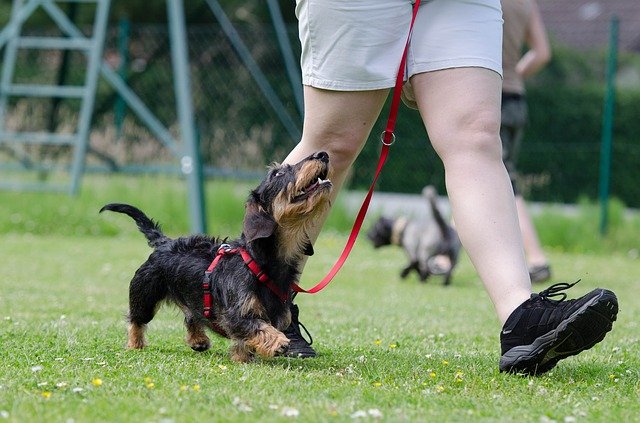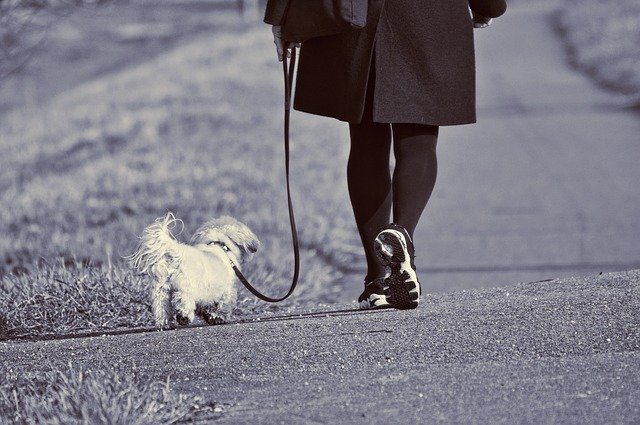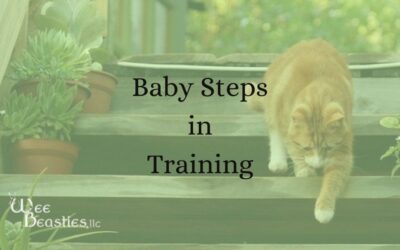Loose leash walking can be a lifesaver! (And if you’ve ever been dragged by a dog on leash, you know what I’m talking about!) Let’s take a look athow to ask your trainer for the help you need and then talk about how to train a polite loose leash walk!
A common question trainers get when it comes to mannerly leash walking is “Can you teach my dog to heel?”
However, “heel” might look different to different people—Are you talking about the formal obedience behavior? Walking nicely on leash? Coming to your side?
In relation to dogs, heel is actually a very precise and complex behavior that is used in a few dog sports such as obedience, rally, protection sports, etc. The heel behavior looks like your dog moving along beside you with their head lined up with the seam of your pant leg on your left side.
It’s also a very formal behavior that the average dog guardian rarely needs.


Most of us actually need something much simpler!
This versatile behavior is simply called “loose leash walking.” It’s handy for walking with your dog through the park, in a pet-friendly store, through the vet’s office, and more!
Our loose leash walking behavior has far fewer requirements than heel. It consists of your dog walking along with you close enough that your leash makes a sort of “J” shape between the two of you. You can let your dog walk on whichever side of you that you prefer.
Loose leash walking is a much simpler behavior than heel, but it may or may not be easy to teach, depending on your dog’s leash walking history. It’s not impossible though, so hang in there!
How to Train Loose Leash Walking
Loose Leash Walking is taught with literal tiny steps!
Baby Steps
To start, choose a quiet room of your house, preferably one you can close off with a door or gate so your dog will stay with you, and you won’t be interrupted by others.
Be sure to bring plenty of treats, your clicker, and your leash!
Clip your leash to your dog’s collar, and then let them drag it. Ironically, learning to walk nicely on the leash doesn’t have to start with anyone actually holding the leash!
Introduce the Leash
If your dog has never been on a leash before, you’ll want to introduce the leash first. I like to show the dog the leash and give them treats for investigating it. Next, I’ll clip it to their collar or harness and just let them drag it while we do something else, such as play tug or fetch or maybe practice any tricks they know. When your dog or puppy can focus on playing or training with you with the leash on, you’re ready to start learning loose leash walking!
Get your dog’s attention with kissy noises or treats and encourage them to come to your side
Once your dog is at your side, take one single step, and then bend down and place a treat by your foot. If your dog moves with you or catches up to you before you lay the treat down, go ahead and click before placing the treat on the floor. After a few steps, your dog should start moving with you. Click when they catch up to you and then treat.
Repeat this step a few times until your dog is readily catching up with you.
Next, we’ll start to mix things up a little. Take TWO steps before you treat your dog (click if they move toward you!). They’ll catch on pretty quick. You can mix in one step, then two, then one.
After a round of one and two steps, you can start adding more steps with your dog still dragging their leash.
If you need to split your training session and start again later, start with the number of steps you made it to in the last session as a warm up, and then add steps again.
When your dog is doing well catching up to you no matter how many steps you take, it’s time to pick up the leash!

This image shows a nice example of the “J” shape we’re looking for. Notice how loose the leash is and how it dips down between the woman and her dog.
The Starting Point
Decide which side you want your dog to walk on (though you’ll want to practice the opposite side too at some point) and encourage your dog to stand next to you while you hold the leash in your hand. The leash should dip down from your dog’s collar toward your feet and then rise up again toward your hand in a loose “J” or “U” shape.
Take a single step, click your dog if they follow, and then bend down to put a treat by your foot on the ground. If your dog has walked on the leash before and has a tendency to pull ahead of you, you can also put the treat behind you, say at your heel or a little further back.
The Cookie Zone
We won’t always treat our dog right next to us because we want our loose leash walk to be relaxing. The only requirement is that the leash stay nice and loose. That’s where our “Zone of Reinforcement” or “Cookie Zone” comes into play!
The Cookie Zone is a sort of semi-circle on the side your dog is walking on where they can go without tightening the leash. It can be ahead, behind, or beside you.
For now, we’ll do most of our rewarding beside and behind us because any dog that has walked on leash before probably already has plenty of reward history in front!

And that’s pretty much it for the basic behavior! Your dog should be pretty reliably walking on a loose leash near you in the room you’re training in.
Next Level
However!
We can’t just walk circles inside a room in our house all day!
And unfortunately, the world outside is full of distractions that our training room doesn’t have, so we’ll need to start adding a few things to make our basic behavior useful outside.
- Different Rooms: First up, try practicing your basic behavior in different rooms of your home. Don’t be upset if your dog suddenly has no idea what to do. Simply back up to taking one step at a time, clicking, and treating when your dog catches up to you, and then work your way back up from there.
- “New” Things: Choose ONE thing to start with and add it to whatever room you’re practicing in (once your dog has the basic behavior down in that room). You can turn on the tv or a radio. Put your dog’s favorite toy in sight (but out of reach for now). Put something tasty or smelly in the room (also out of reach for now). Practice walking by them. (It’s okay to let your dog sniff as long as they don’t pull you toward the thing. If they pull, move the thing further away or make it smaller or less tasty/smelly.)
- People: Have a person your dog already knows well come by to help you. Have them sit quietly in the room while you practice your basic exercise. When your dog gets good at walking by a seated person, have the person stand up, and later, you can have them move around the room.
Building Distractions
Talking about building distractions into your training is a whole blog post all by itself (more on that later!), but the general idea is that we want to start with very simple versions of our distraction and build up to more complicated versions.
For locations, we start with quiet, familiar locations and work our way up to more exciting and new ones. For example, we start in a single room in our house, then try the other rooms, and then we move outside—first to our own yard and then to other yards or parks!
For noises or sounds, we start with very quiet ones and gradually increase the volume to natural levels, and for toys and food, we start with less interesting versions before moving up to the good stuff.
For people, we start with our person sitting and being quiet. This makes them an easy distraction on two fronts—they’re smaller because they’re sitting, and they’re less engaging because they’re quiet. We’ll work our way up to a relaxing walk while small children run screaming through the park later!
In addition to making changes in familiarity, sound and interest level, etc.making things easier to deal with, putting more distance between ourselves and the distraction can also make it easier to deal with.
You can mix and match your distractions as your dog gets better at walking well around them. Just make sure that you only increase the level of one distraction at a time.
Practice Makes Perfect
Even when your dog starts walking with a wonderfully loose leash most of the time, it’s still handy to practice from time to time. Have fun coming up with new and interesting challenges to practice around, and your dog will have lots of great reward history for loose leash walking in no time!

How to Move Your Dog Through Tight Spaces on Leash
While walking with your dog on a nice loose leash is great, there are times when you’ll need your dog to walk much more closely by your side—perhaps on a crowded sidewalk or down a busy store aisle.
You can of course train your dog to heel for these situations, but if you don’t have the time for that, you can use a simple food lure to guide them through the tricky situation.
Simply take a tasty treat in your fingers, put it right against their nose, and walk through the tight spot you’ve come across.
By placing the treat right on your dog’s nose, you can control how close they are to you and how quickly the two of you navigate the tight spot.
Let your dog have the treat after you get through the spot and be sure to praise them (and even reward them again) for a job well done!
Let’s Rock the Walk!
And there you have it! Loose leash walking is a simple behavior, but it may not be so easy to accomplish in real life, especially if your dog has had lots of practice pulling on the leash before you try to train it.
Don’t despair! Any dog can learn to walk nicely on leash. It’s just a matter of perseverance and patience on your part!
Sometimes, it’s easier to deal with this kind of thing with friends and help, so I’m happy to announce that this spring, I’ll be holding regular “Rock the Walk” sessions in various places around Fayette, Raleigh, and Greenbrier Counties!
Rock the Walk will be a drop in program—simply RSVP to the date you want to attend and send me your dog’s vaccination records so I know you’ll be safe from doggy germs in public spaces.
At our meeting, we’ll take a 30 minute walk where I’ll move back and forth through the group providing pointers as we practice our loose leash walking skills.
At the end, we’ll relax and visit with some refreshments before heading home.
Locations and dates/times will be sent via email to those interested so I can make sure all dogs attending are vaccinated. If you’d like to be notified when Rock the Walk gets started, please sign up here!





